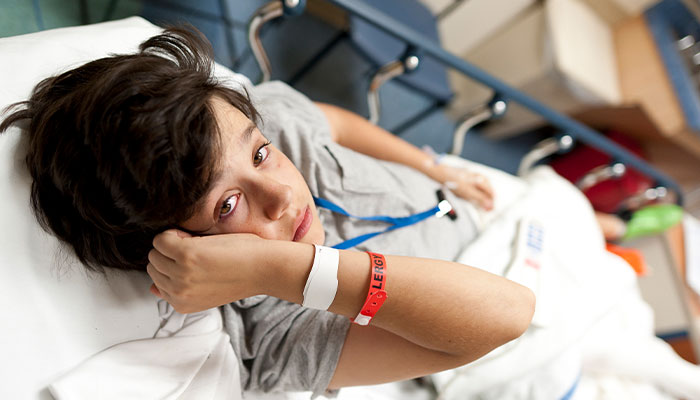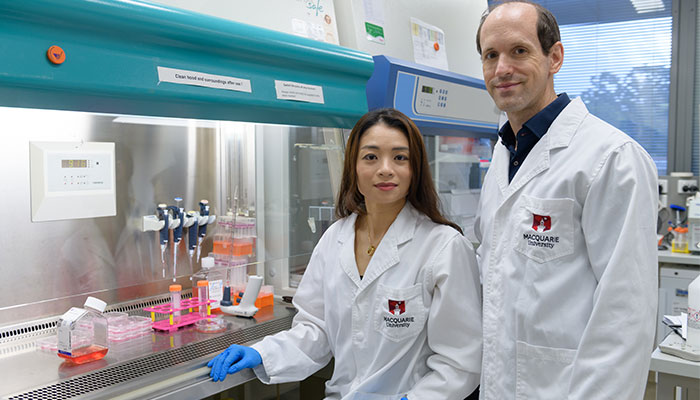The day before her son’s seventh birthday, Mary Van Kemenade learned she had breast cancer and would need a mastectomy, including the surgical removal of her lymph nodes.
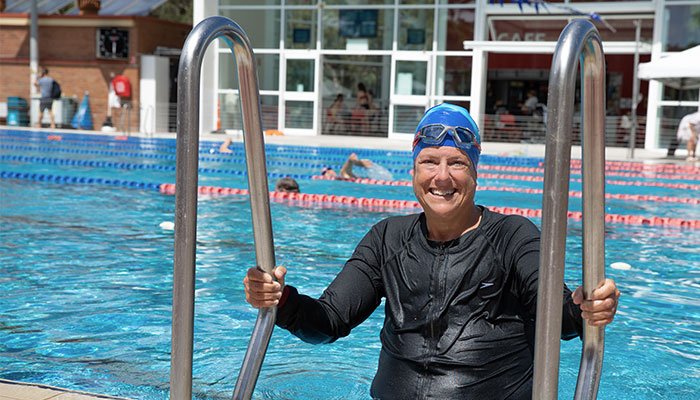
Water therapy: Lympheodema patient Mary Van Kemenade credits swimming as a vital part of both her recovery. Photo credit: Maja Baska.
“I knew a little bit about lymphoedema, and my immediate fear was that I’d end up with this hugely swollen arm, so that was one of the first things I asked my surgeon,” Mary says.
Located in the armpits and both sides of the groin, lymph nodes drain away any fluid that has leaked from blood vessels into the surrounding tissue.
Having these nodes surgically removed or irradiated can result in lymphoedema: swelling, most commonly in the limbs, that causes pain, heaviness and restriction of movement. This swelling can be disfiguring, and once it has developed, it is irreversible.
Instead of the patient ending up with an arm or leg that’s up to twice the size of the unaffected limb, the swelling can be controlled.
While lymphoedema may be present from birth or develop due to trauma, one in five cancer patients who lose lymph nodes are likely to develop the condition.
Luckily for Mary, her surgeon immediately referred her to the Australian Lymphoedema Education, Research and Treatment (ALERT) Program at Macquarie University.
ALERT was an early adopter of a breakthrough in lymphoedema monitoring that new research has now shown to be more effective at preventing and managing the condition than traditional means.
Macquarie University lymphoedema researcher Dr Louise Koelmeyer led the Australian arm of an international study comparing the effectiveness of bioimpedance spectroscopy to the traditional method of using a tape measure to detect increases in swelling in limbs where the lymph nodes have been removed.
Bioimpedance spectroscopy is the key to Queensland biotech Impedimed’s SOZO Platform, a piece of non-invasive equipment that can measure a range of health information including lymphoedema index, heart failure index, intra- and extracellular fluid, and skeletal muscle mass in less than 30 seconds.
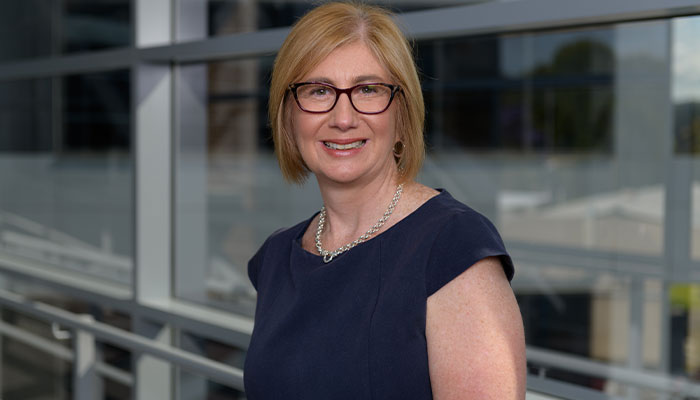
Making a difference: Dr Louise Koelmayer says early detection means cancer patients have one less thing to worry about.
Koelmeyer says the platform detects small increases in extracellular fluid before any other changes are noticeable.
“By the time you record a change in the circumference of the limb using a tape measure, it may already be too late to prevent the worst effects of lymphoedema, so this early detection is absolutely vital,” she says.
“Instead of the patient ending up with an arm or leg that’s up to twice the size of the unaffected limb, the swelling can be controlled, in some cases preventing lymphoedema altogether.”
Treatment involves getting patients to wear compression garments immediately, as well as exercise, good skin care and manual lymphatic drainage massage to improve lymph drainage.
Some people may still go on to develop lymphoedema, but catching it early reduces the need for intensive long-term treatment, and the size difference between the limbs may not even be noticeable.
Koelmeyer says it’s never too early to begin monitoring.
- '25 blows to the head': New help for sport head trauma patients
- Exhibition spotlights 206 years that changed the world forever
“You can start seeing a lymphoedema therapist who measures using bioimpedance spectroscopy as soon as you learn you are likely to need lymph node treatment,” she says.
“Lymphoedema is not only painful and debilitating, but people become very self-conscious because of the effect on their appearance. It’s not uncommon to need clothing one or two sizes bigger to accommodate the swollen limb.
“Being able to detect the warning signs early means cancer patients have one less thing to have to worry about at what is already a very difficult time.”
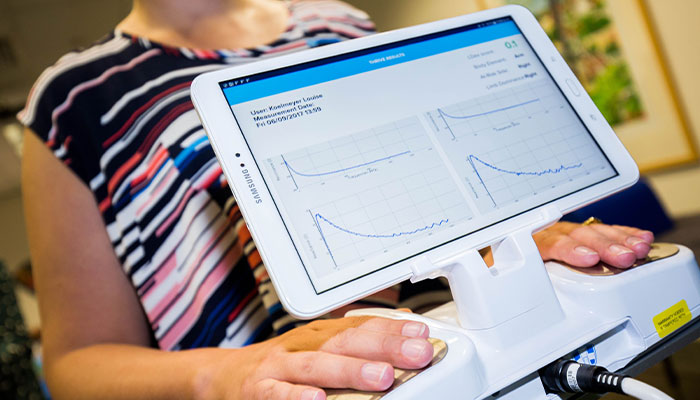
Non-invasive: The SOZO Platform can detect small increases in fluid before any other changes are noticeable.
The Australian Lymphoedema Education, Research and Treatment (ALERT) Program at Macquarie University researches improved treatments and preventions, cares for patients within a multidisciplinary clinic, and runs an education program that draws health professionals from around the country.
Other discoveries from ALERT in recent years have included conclusive evidence using indocyanine green lymphography (ICG) imaging that shows in real time that firm and slow massage is more effective than the previously accepted gentle massage in helping drain fluid from affected limbs. This research has helped in empowering individuals to achieve better outcomes in their self-management.
Mary’s story
Mary Van Kemenade’s initial cancer diagnosis was three years ago, when she was 46, and since then she has had a bilateral mastectomy involving the removal of lymph nodes on one side, followed by chemotherapy and radiotherapy.

Taking control: Mary Van Kemenade says ALERT has given her the tools to manage her lymphoedema. She also credits swimming as a vital part of her treatment. Photo credit: Maja Baska.
“I had ALERT’s advice from the very beginning on things like lymphoedema monitoring, prevention and treatment,” Mary says.
“It was invaluable – it made me feel like I was more in control at a time when I didn’t feel like I was in control of anything.”
Regular monitoring showed that extracellular fluid was increasing in her arm, and while she has gone on to develop early lymphoedema, its effects have been minimised thanks to the early use of compression sleeves, exercise and massage.
Mary also credits swimming as a vital part of both her recovery and her lymphoedema treatment.
I’ve worked like crazy to get the movement back in my arm to make sure I could do simple, everyday things other people take for granted.
“I love swimming more than anything,” she says. “Pool, sea – you name it. I’m swimming every day
“After the lymph nodes were removed, I couldn’t raise my arm over my head, and apparently that’s quite common.
“Some people do not regain the full range of motion – it’s gone for good – but I’ve worked like crazy to get the movement back in my arm to make sure I could do simple, everyday things other people take for granted, like keep dressing myself, driving and swimming.”
Another aspect that Mary says has made a big difference to managing her lymphoedema is learning about the variety of compression sleeves available.
“When you think of compression garments, you think about those older-style beige sleeves, and I hated the idea of those,” she says.
- New study finds post-work wellbeing is not just about money
- Pandemic measures cut rate of salmonella poisoning
“I have trendy sleeves that are ruby red and navy blue that fit in with my wardrobe so well that most people don’t even realise I’m wearing one.
“I can even wear one to swim!
“I can’t cure my lymphoedema, but I have the tools to manage it thanks to the team at ALERT, and that makes all the difference.”
Louise Koelmeyer is the Director of the Australian Lymphoedema Education, Research and Treatment (ALERT) Program at Macquarie University

